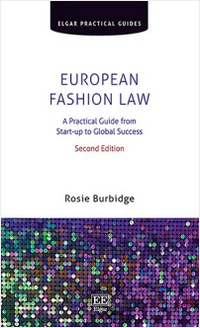Now in its twelfth year, Class 46 is dedicated to European trade mark law and practice. This weblog is written by a team of enthusiasts who want to spread the word and share their thoughts with others.
Click here subscribe for free.
Who we all are...
Book review: European Fashion Law (second edition)
 Charlotte Duly of the MARQUES Education Team reviews the recently released second edition of European Fashion Law, by fellow MARQUES member Rosie Burbidge (published by Edward Elgar Publishing, priced from £80 and available here).
Charlotte Duly of the MARQUES Education Team reviews the recently released second edition of European Fashion Law, by fellow MARQUES member Rosie Burbidge (published by Edward Elgar Publishing, priced from £80 and available here).
The second edition of this book is significantly updated from the first and includes not only developments in case law and legislation but considerations on the state of the fashion industry due to advancing areas such as digital fashion. Of course, Brexit is ever present and the changes due to this seismic event are also incorporated.
The book focuses on the position in the United Kingdom and EU, with particular emphasis on the key fashion capitals of London, Paris and Milan.
Quite simply, this book is a joy to read. It is beautifully laid out, with a helpful visual key and practical tips that may not strictly cover legal issues but are useful to read from a commercial perspective. Whilst fashion law is not a defined legal area as such, there are core issues that affect fashion businesses and these are covered in a clear and concise manner.
There is a focus on intellectual property and, of course, trade marks, copyright and designs feature in detail, but there are other aspects included such as incorporating a company and contractual issues that relate to fashion businesses, including agency and distribution agreements. Of particular relevance to many, not just those in the fashion industry, is the section about posting online and considering the IP rights involved as well as other aspects of publicly sharing.
The book acknowledges that in the fashion business, at some point or another, parties are likely to find themselves both “wielding the weapon” of their IP sword and being on the receiving end of such armoury.
Fashion is a fast-paced industry, driven by changing seasons and trends, and the difference between following such a trend and copying can be blurred. This book highlights the importance of securing IP rights at the relevant time (as soon as possible!) whilst acknowledging that disputes do happen and provides guidance when that is the case.
There is a useful discussion on unregistered rights, in particular copyright and unregistered design rights, and the territories where registration of copyright should be considered. Practical tips including collating evidence of unregistered rights and dated copies of work are incredibly useful, as is the high-level summary of the various options for protecting a design at European level, including the UK, comparing registered designs, unregistered design rights and copyright.
Working with models can add complexity to a fashion business. Image rights are important in the fashion industry but often used without definition and there is consideration of whether models can claim their runway performances are protected by performers’ rights. There is a helpful discussion of issues to consider when contracting with models around these topics. Other important issues that a business would need to factor in such as regulation, data security and VAT are also covered.
The new chapter on digital fashion provides an accessible review of the issues where consumer interaction with brands has altered and is continually developing as businesses enhance their output to produce both physical and digital goods.
“Phygital fashion”, being a combination of physical and digital elements such that the physical products have a digital counterpart existing in a virtual environment, and other important novel terminology is explained in a simple and accessible manner.
A further new addition is a chapter on circular fashion and the trend for upcycling and other uses of products. This is an important area that will continue to grow as we remain ever mindful of environmental issues and the need to reign in the throwaway fashion lifestyle of the past.
The penultimate chapter of the book is called “Selling Up” and includes key considerations for how to end a business, whether that is due to retirement, or for some other reason. It is crucial to consider the exit plan at the start of any new venture!
Let’s hope that, having produced a second edition of an excellent book covering a wide range of issues that any business should consider, not just those in the fashion industry, Rosie Burbidge does not consider selling up just yet and continues her endeavours in the field of IP and fashion law.
Charlotte Duly is Vice-Chair of the MARQUES Education Team. The Team contributes occasional book reviews to Class 46. The picture shows the cover of European Fashion Law
Posted by: Blog Administrator @ 08.24Tags: book review, fashion law, Rosie Burbidge,


 Sharing on Social Media? Use the link below...
Sharing on Social Media? Use the link below...Perm-A-Link: https://www.marques.org/blogs/class46?XID=BHA5390

